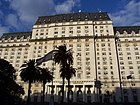Monserrat, Buenos Aires
Monserrat | |
|---|---|
Cabildo, South Diagonal and Casa Rosada . | |
|
ART ) |
Monserrat


Avenida de Mayo runs through the Monserrat district, connecting Plaza de Mayo and the Plaza de los Dos Congresos (Congressional Plaza).
A block, or two, south of the Plaza de Mayo, the older section of Monserrat begins. This is Buenos Aires' oldest neighborhood and even today, very little of the cityscape there is less than a hundred years old (except along
History
The Monserrat area traces its origins to the foundation of Buenos Aires itself, when, in 1580, Spanish
Little changed over the next seventy years, Monserrat's muddy shore and typically colonial grid of cobblestone streets came under a rapid modernization following Argentina's sudden economic development after 1875. Land reclamation and the creation of docks parallel to the area led to the construction of Paseo Colón (still a major thoroughfare) along Monserrat's eastern edge. The area's two adjoining squares became the
The area's led central location and its presence therein of much of Argentina's governmental structure led to monumental construction over the next twenty years, notable among which are the
Among its historic buildings is the house where Viceroy Santiago Liniers lived. This historical site is known by the name of Casa de Liniers, and is located on the street Venezuela 469.[4] Another of the historical sites is the Iglesia Presbiteriana San Andrés, a Presbyterian church located on Belgrano Avenue.[5]
Gallery
-
Vintage entrance tosubte Line A of the Buenos Aires Metro on Avenida de Mayo; behind it, City Hall
-
Architectural contrasts on the Avenida de Mayo
-
Typical vintage corner in Monserrat
-
Eastward view of the Plaza de Mayo and Casa Rosada
-
TheJesuit Temple of St. Ignatius and the colonial Illuminated Block
-
The Ministry of Defense, the Libertador Building
-
City Historical Museum
-
Tomb of Argentine patriotSanto Domingo Convent
-
Corner of South Diagonal and Belgrano Avenues
-
Monument to Mariano Moreno
-
Otto Wulff Building, Belgrano Avenue
-
Corner ofRivadavia Avenue
-
Buenos Aires Police Headquarters
Notes
- ^ Pronounced [munsəˈrat] in standard eastern Catalan
- ^ Montserrat[a] is the original Catalan name, but both spellings are used today.
References
- ^ "The emblems of the 48 barrios of Buenos Aires were presented" (Spanish) by ámbito.com August 29, 2011
- ^ "Map of Monserrat – City Government of Buenos Aires".
- ^ "Montserrat". Buenos Aires Ciudad - Gobierno de la Ciudad Autónoma de Buenos Aires (in Spanish). Retrieved 2020-04-12.
- ^ Venezuela 469 (Casa del Virrey Liniers). Centro de Arqueología Urbana. 22 April 2014.
- ISBN 9789876279697.
External links
- Map of Monserrat (in Spanish)















